There’s a new guidebook out for the cicadas of New Zealand. The book was produced by 10-year-old Olly Hills — proof that there are few age barriers to scientific interest and research.
Category: Locations
Locations where cicadas can be found, including countries and continents.
Four new species of Semia cicadas living in Vietnam were described in 2017: Semia magna, Semia spiritus, Semia pallida, and Semia albusequi.
Here’s the details on the paper:
Title: Descriptions of four new species of Semia Matsumura (Hemiptera: Cicadidae: Psithyristriini) from Vietnam, with a key to the species of Semia
Authors: David Emery, Young June Lee, & Thai Pham.
Year: 2017
Publication: Zootaxa. 4216. 153-166.
Document link: https://biotaxa.org/Zootaxa/article/view/zootaxa.4216.2.2
Abstract:
This paper provides descriptions of four new species of the genus Semia Matsumura, 1917 from Vietnam: Semia magna sp. nov., Semia spiritus sp. nov., Semia pallida sp. nov., and Semia albusequi sp. nov. A key to the 13 species of Semia is provided.
Update: this cicada has a Leap-Year Brood (2024) as well as a World-Cup Brood (2026)! Both have 4-year year life cycle.
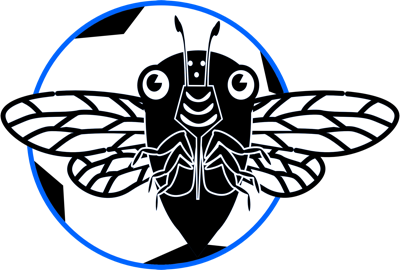
Chremistica ribhoi Hajong and Yaakop 2013 is a cicada that lives in the Ri-Boi district of India. C. ribhoi is known as the World Cup cicada because it emerges every four years in synch with the World Cup association football (soccer) tournament.
C. ribhoi is known locally as Niangtasar. It only lives in a very small area: Saiden village (25°51’37.1″N 91°51’16.3″E) and Lailad/Nongkhyllem Wildlife Sanctuary (25°55’09.7″N 91°46’25.0″E) situated on the northern part of the state of Meghalaya. The cicada can be identified by the presence of two white spots on either side of the anterior abdominal segment.
Researcher Sudhanya Hajong is gearing up to study these cicadas since this is the year they will emerge. Ri-Boi area locals use these cicadas as a food source and fish bait. These cicadas are threatened by deforestation (cutting down forests for agricultural purposes). Sudhanya plans to educate locals about conserving them and protecting their habitat.
Most of the facts in the post come from the following document: Hajong, S.R. 2013. Mass emergence of a cicada (Homoptera: Cicadidae) and its capture methods and consumption by villagers in ri-bhoi district of Meghalaya. Department of Zoology, North-Eastern Hill University, Shillong – 793 022, Meghalaya, India.
Thanks to Chris Simon of The Simon Lab at UCONN for providing the information that made this post possible.
Note: the image in this article is not an accurate depiction of C. ribhoi. 🙂
There’s also a brood of C. ribhoi that emerges during Leap-years.
Cicada researcher Robert L. Sanders has written a paper documenting a 3-Year survey of Oklahoma cicadas. The paper is appropriately titled “A 3-Year Survey of Oklahoma Cicadas (Hemiptera: Cicadoidea: Cicadidae) with New State Records” and was published in Journal of the Kansas Entomological Society, 89(4):315-337. Access it via this link.
The number of cicadas identified living in Oklahoma has been raised to 41. The previous number, as documented in the works of Allen F. Sanborn and Polly K. Phillips, was 341.
Here’s the abstract of Robert’s paper:
ABSTRACT: Between September of 2013 and September of 2016 an intermittent survey of the cicada diversity and distribution in Oklahoma was conducted. The results of this survey are presented here as a current updated annotated checklist. Seven species in four genera are newly recorded as resident in Oklahoma: Diceroprocta texana (Davis, 1916), Megatibicen figuratus (Walker, 1858), Neotibicen davisi harnedi (Davis, 1918), Neotibicen linnei (Smith & Grossbeck, 1907), Neotibicen robinsonianus (Davis, 1922), Okanagana viridis Davis, 1918, and Pacarina shoemakeri Sanborn and Heath, 2012. This brings the total number of species inhabiting the state to 41. Discussed are seven additional species possibly occurring in the state and Oklahoma’s cicada diversity.
1 Sanborn Allen F. Phillips, Polly K. (2014). Biogeography of the Cicadas (Hemiptera: Cicadidae) of North America, North of Mexico. Diversity 2013, 5, 166-239; doi:10.3390/d5020166
There’s a new paper from Sarah E. Banker, Elizabeth J. Wade, and Chris Simon titled “The confounding effects of hybridization on phylogenetic estimation in the New Zealand cicada genus Kikihia”.
Here are the highlights:
- Tested validity of an unexpected “Westlandica” mitochondrial clade with nuclear loci.
- Phylogenetic signal and pattern differ dramatically among nuclear genes but always weak on South Island.
- No conflict between nuclear concatenation vs species trees from multiple methods.
- Three nuclear species trees support major North Island but not South Island mitochondrial clades.
Here’s the citation information:
Sarah E. Banker, Elizabeth J. Wade, Chris Simon, The confounding effects of hybridization on phylogenetic estimation in the New Zealand cicada genus Kikihia, Molecular Phylogenetics and Evolution, Volume 116, November 2017, Pages 172-181, ISSN 1055-7903, https://doi.org/10.1016/j.ympev.2017.08.009.
(https://www.sciencedirect.com/science/article/pii/S1055790317302348)
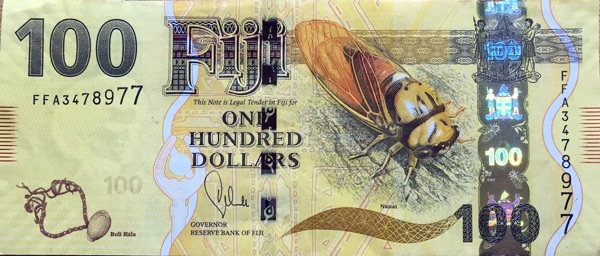
This cicada will next emerge in 2025.
Update (11/4/2017): from Facebook, it looks like folks are finding them. Here’s an image.
Update (9/13/2017): the Nanai have begun to emerge! This cicada last emerged in 2009 in Nadroga-Navosa and Serua Provinces, and now again emerge in 2017.
Notes from Chris Simon:
Early this morning I got the first Reports of the 8-year periodical Nanai emerging in Navosa, Fiji! Some people in that area had them for dinner.
This confirms earlier reports of the eight-year periodicity. There was some uncertainty because the original specimens were dated (1906) a year later than they would be if on the current 8-year schedule.
Duffels and Ewart (1988, The Cicadas of the Fiji, Samoa, and Tonga Islands, their taxonomy and Biogeograohy) noted that “Until recently the present species is only known from three males collected in “Fijii” in 1906 by C. Knowles.” Duffels was not able to describe them when he first saw the specimens because they were missing the male genitalia. After obtaining, “a series of females and two males” from Dick Watling and Andrew Laurie in 1986, Duffels was able to assign it to the genus Raiateana. There is one other species of Raiateana in Fiji, R. kuruduadua (two subspecies in Fiji and one in Samoa) but it is not periodical as far as we know.
You might be familiar with American periodical cicadas (Magicicada) and the World-cup synchronized Chremistica ribhoi of India, but Fiji has a periodical cicada too: the 8-year periodical Nanai cicada aka Raiateana knowlesi.
It also appears on Fiji’s $100 note.
There’s even a local legend about the cicada.
More information:
Thanks to Chris Simon of the University of Connecticut for this information.
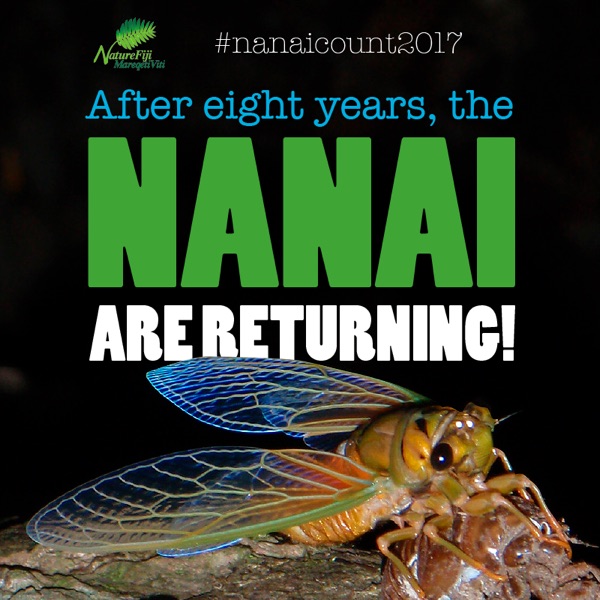
More shots of the Fiji $100 note and the folder it comes in:
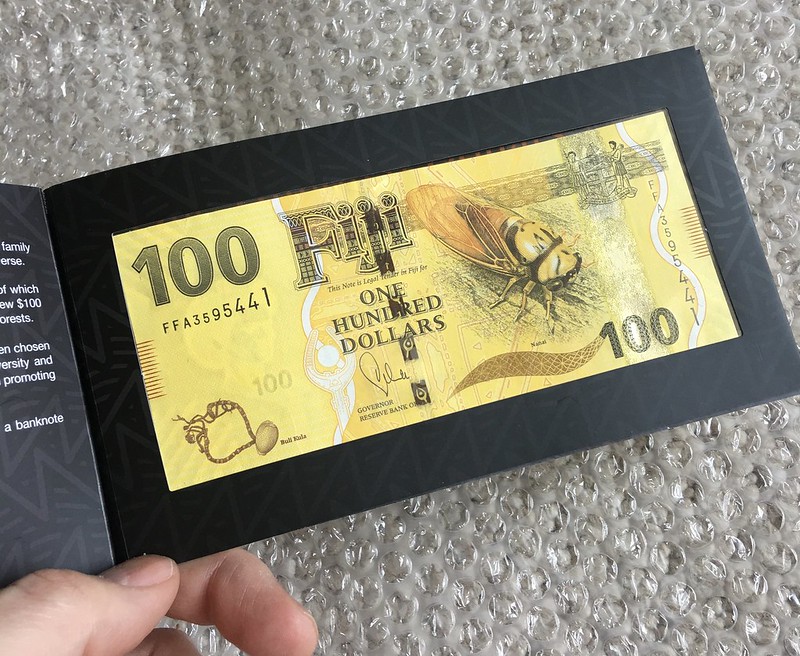
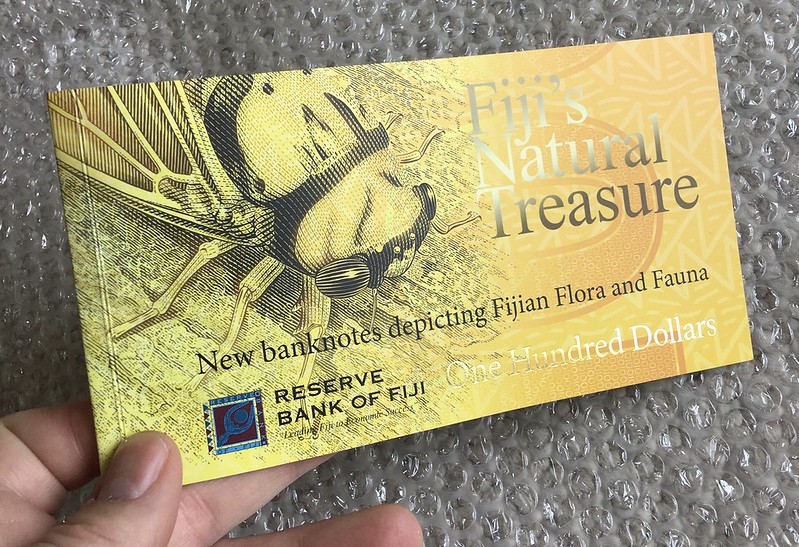
Lindsay Popple published a new paper describing 14 new species of grassland, woodland & scrubland Myopsalta cicadas. Download it from Zootaxa.
Here are the particulars:
Volume: Zootaxa 4340 (1): 001—098; 2017.
Title: A revision of the Myopsalta crucifera (Ashton) species group (Hemiptera: Cicadidae: Cicadettini) with 14 new species from mainland Australia
Author: LINDSAY W. POPPLE
Abstract:
The genus Myopsalta Moulds is distributed throughout much of Australia. Previous studies have associated several undescribed species with the Myopsalta crucifera (Ashton) species complex. The present study informally divides the cicadas in the genus Myopsalta into two species groups. It provides a revision of the M. crucifera species group, which includes redescriptions of M. crucifera s. str. and M. mackinlayi (Distant). The identity of the latter species is further refined and attributed to material formerly presented under the name Myopsalta atrata (Goding & Froggatt). In addition to the redescriptions, 14 new species belonging to the M. crucifera species group are described, including M. albiventris n. sp., M. bassiana n. sp., M. chrysopedia n. sp., M. gordoni n. sp., M. leona n. sp., M. longicauda n. sp., M. majurae n. sp., M. melanobasis n. sp., M. parvula n. sp., M. platyptera n. sp., M. riverina n. sp., M. septa n. sp., M. umbra n. sp. and M. xerograsidia n. sp. A key to species in the genus Myopsalta is provided. Standard morphological descriptions and descriptions of calling songs unique to each species are included along with a discussion on different song types in the M. crucifera species group.
And the announcement from Twitter:
My paper describing 14 new species of grassland, woodland & scrubland Myopsalta cicadas was published today. Study funded by @BushBlitz2 https://t.co/rnBuwXwIn2
— Lindsay Popple (@_DrPop_) October 27, 2017
The book Vol 4340, No 1 was published today.https://t.co/FtKHNUhjbf pic.twitter.com/AyIH4kRPvR
— Zootaxa updates (@Zootaxa) October 27, 2017
Lindsay Popple announced on Twitter that two new species of Clinopsalta cicadas have been described.
New species of Clinopsalta cicadas paper published: https://t.co/ZaZQP9xcAk. Download and listen to their calls here https://t.co/xmPxPASia7 pic.twitter.com/M35HaZ1NAF
— Lindsay Popple (@_DrPop_) September 18, 2017
Links:
Sounds: Calling songs of Clinopsalta cicadas.
Journal Article: TWO NEW SPECIES OF CLINOPSALTA MOULDS (HEMIPTERA: CICADIDAE) AND ADDITIONAL DISTRIBUTION RECORDS FOR CLINOPSALTA ADELAIDA (ASHTON), WITH NOTES ON THEIR DISTINCTIVE CALLING SONGS. Popple and Emery, 2017. Rec. Aust. Mus. 69(4): 237—256
Abstract from the journal article:
Two new species are described in the genus Clinopsalta Moulds. Clinopsalta autumna sp. nov. exhibits a warm temperate distribution from south-east Queensland south to Goulburn and Nerriga in eastern New South Wales. Clinopsalta semilunata sp. nov. has a patchy distribution in southern Queensland from Binjour Plateau west to near Miles, south to Yelarbon State Forest and Durikai State Forest, both near Inglewood. In addition to the descriptions of these new species, further distribution records are provided for C. adelaida (Ashton), which extend its distribution from south-eastern South Australia and northern Victoria to inland central and northern New South Wales. The species of Clinopsalta are small—medium sized cicadas (< 20 mm body length) with distinctive calling songs of an intermediate frequency (c. 6 to 18 kHz). The temporal structures of the calling songs follow a similar pattern in each species, comprising an introductory rattle followed by a series of clicking phrases. The call is characteristically accompanied with bouts of prominent wing-snapping, except in one species (C. semilunata sp. nov.).
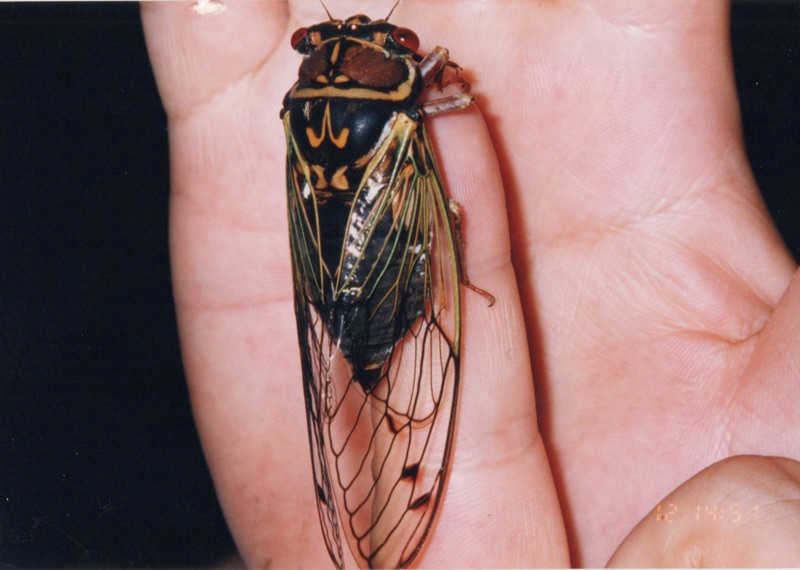
Photo: Auritibicen japonicus by Osamu Hikino.
Cicada season in Japan, like North America, seems to be best from June to September, peaking in August. Different cicada species emerge at different times of the year, but the majority of them are active during the summer.
The best website for the cicadas of Japan that I’ve come across is Cicadae in Japan which is run by Y. Saisho who co-wrote the amazing The Cicadidae of Japan book & CD.
I don’t have too many photos of cicadas from Japan on this site, but here are some of the more well known (Genus names may have changed recently):
Auritibicen flammatus (formerly Tibicen flammatus, Lyristes flammatus)
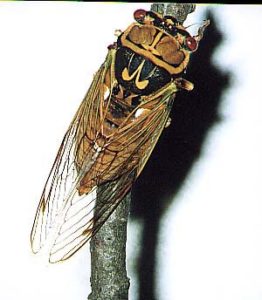
Photo by Osamu Hikino.
Auritibicen japonicus (formerly Tibicen japonicus, Lyristes japonicus)
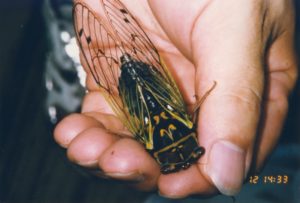
Photo by Osamu Hikino.
Graptopsaltria nigrofuscata
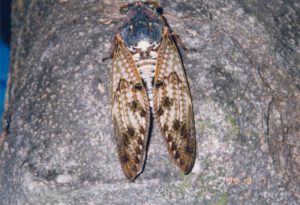
Photo by Osamu Hikino.
Here’s a video from the YouTube:
Auritibicen kyushyuensis
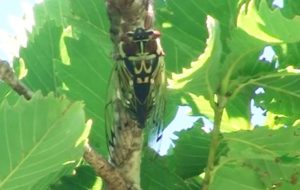
Photo by Osamu Hikino.
Hyalessa maculaticollis
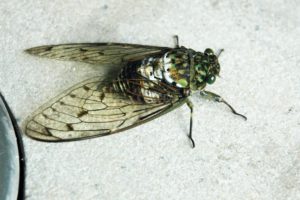
Platypleura kaempferi
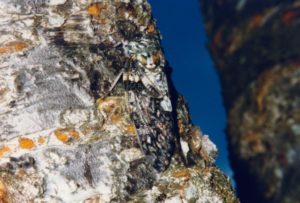
Photo by Osamu Hikino.
Tanna japonensis
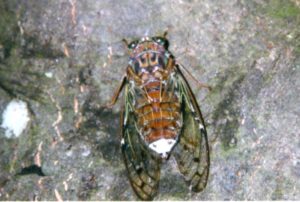
Photo by Osamu Hikino.
Euterpnosia chibensis
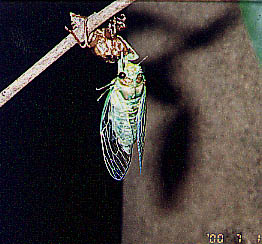
Photo by Osamu Hikino.
Yezoterpnosia nigricosta
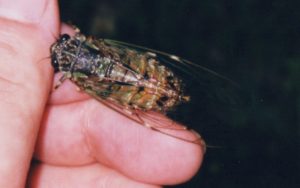
Photo by Osamu Hikino.
Cicadas are very popular in Japan, and they find their way into pop culture (Anime, live action kids shows like Ultraman). This photo features a cicada toy when spun, makes a sound, some cicada clicker toys, a plush Oncotympana, a Seminingen (bad guy from Ultraman), and Yotsuba a green-haired girl who has caught a cicada (Lyristes japonicus perhaps):
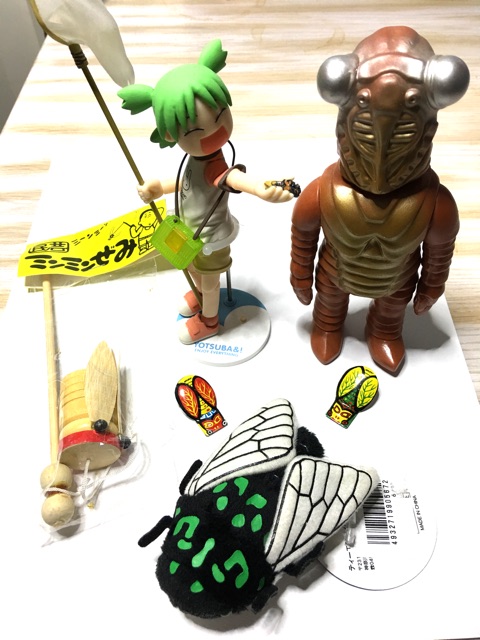
Cicada News & Photos
The best place, I’ve found, to keep track of which cicadas are out in Japan is Twitter. You can search Twitter yourself for セミ and you’ll find many results — most Tweets are references to pop culture, but occasional photos and actual information about actual cicadas.
These are many of the Twitter feeds I follow. You don’t need to belong to Twitter to view their feeds, but it’s more fun if you join.
- ?? ?? ?????? SAISHO, Y. – the person who wrote the book on cicadas from Japan.
- Y.Kohei @YKohei3
- ????? @Cicada_Kaneko
- @cicadamania which is the twitter feed for this site
Bonus:
Here’s a video of a Yezoterpnosia nigricosta taken by Elias Bonaros:
The Dusk Singers
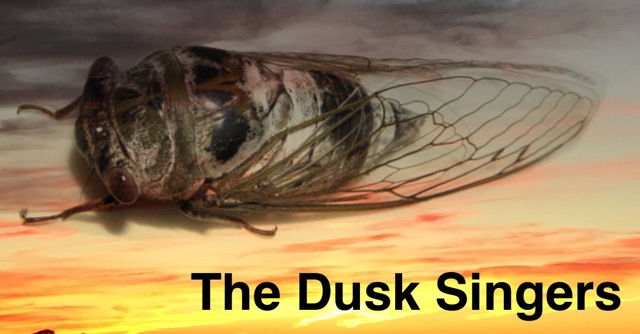
Dusk is the time of day between sunset and night. Many species of Megatibicen & Neotibicen (formerly Tibicen) sing at this time. I’m not sure why they sing at this time — perhaps it helps them avoid audio competition with other singing insects, or perhaps it helps them avoid predators by calling at this specific time of the day.
If you find yourself outdoors in the eastern half of the U.S. after sunset and hear a cicada call, it is likely one of the following Megatibicen or Neotibicen species:
Megatibicen
Megatibicen are LARGE and LOUD cicadas.
Megatibicen auletes aka the Northern Dusk Singing Cicada. This cicada can be found in these states: AL, AR, CT, DE, DC, FL, GA, IL, IN, IA, KS, KY, LA, MD, MA, MI, MS, MO, NE, NJ, NY, NC, OH, OK, PA, SC, TN, TX, VA, WV, WI. Season: July to Fall.
M. auletes Call*:
Megatibicen figuratus aka the Fall Southeastern Dusk-singing Cicada. Found in: AL, AR, FL, GA, LA, MS, NC, SC, TN, TX, VA. Season: July to Fall.
M. figuratus Call*:
Megatibicen resh aka Resh Cicada aka Western Dusk Singing Cicada. Found in: AR, KS, LA, MS, NE, OK, SC, TN, TX. Season: July to Fall.
M. resh Call*:
Megatibicen resonans aka Southern Resonant/Great Pine Barrens Cicada aka Southern Dusk Singing Cicada. Found in AL, FL, GA, LA, MS, NC, SC, TN, TX, VA. Season: July to Fall.
M. resonans Call*:
Neotibicen
Medium-sized, green cicadas with calls that sound like the rhythmic grinding of a scissor on a sharpening wheel (not a common tool in the 21st century).
Neotibicen pruinosus pruinosus aka Scissor(s) Grinder. Found in AL, AR, CO, IL, IN, IA, KS, KY, LA, MI, MN, MS, MO, NE, OH, OK, SC, SD, TN, TX, VA, WV, WI. Season: June – September. Neotibicen pruinosus fulvus aka Pale Scissor(s) Grinder Cicada. Found in: KS, OK. Season: June – September.
N. pruinosus Call*:
Neotibicen winnemanna aka Eastern Scissor(s) Grinder. Found in AL, DE, DC, GA, KY, LA, MD, MS, NC, NJ, PA, SC, TN, TX, VA, WV. Season: June – Fall.
N. winnemanna Call*:
*Audio files are Copyright of InsectSingers.com. Season information gathered from BugGuide.net.